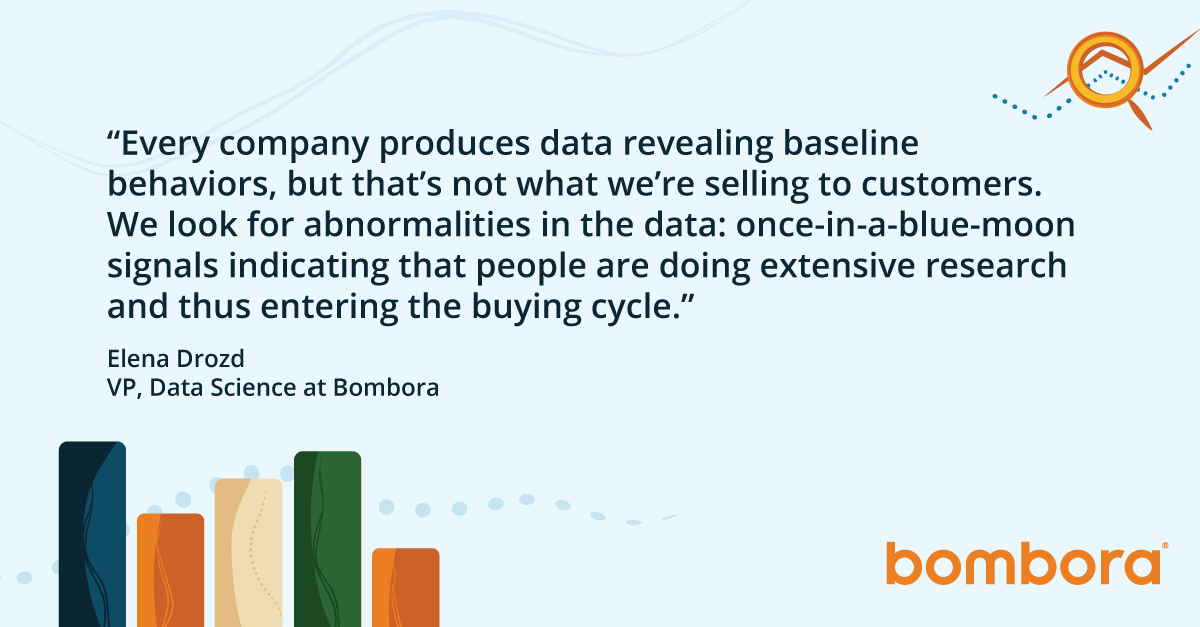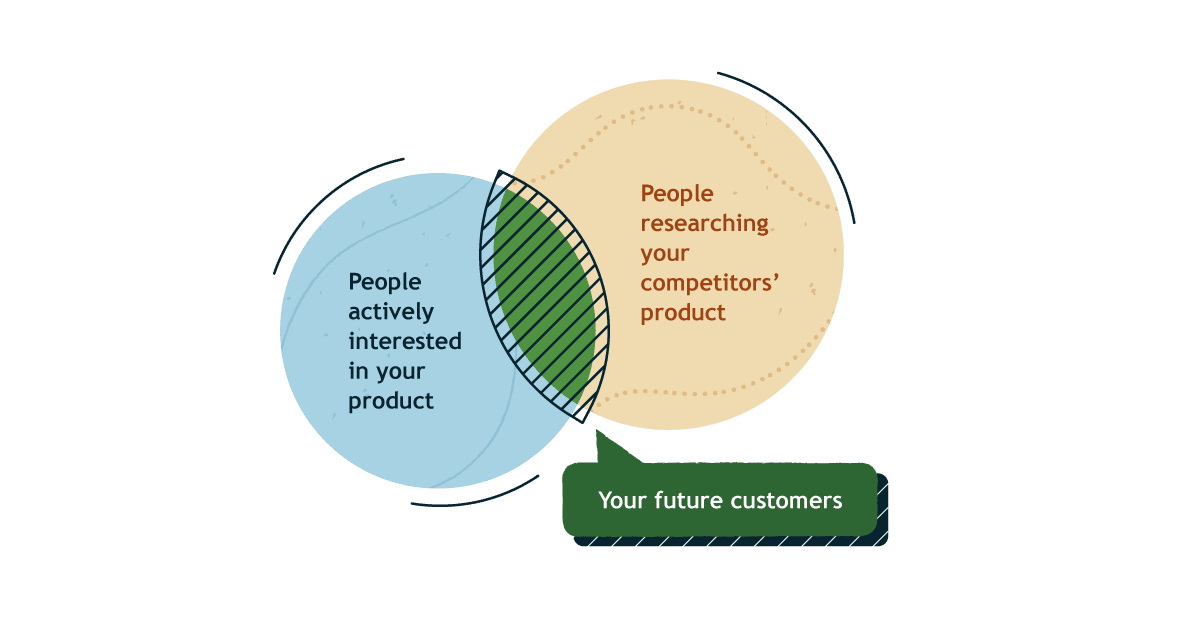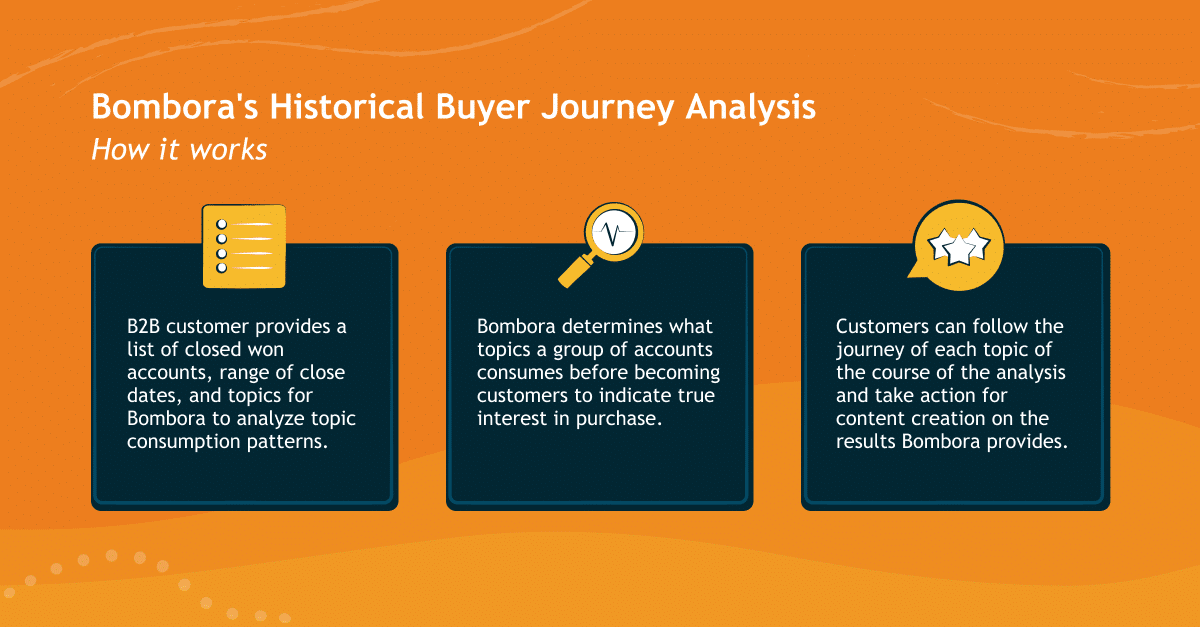Four ways to simplify marketing with B2B Intent data
B2B Intent a.k.a. Intent data makes life simpler for marketers because it reveals the motivations of people planning a purchase.
Wouldn’t this data be most helpful to sales teams? Sure, Intent data answers the most pressing question on a salesperson’s mind: Who wants to buy what I’m selling? Armed with this knowledge, sellers can prioritize accounts to reach out with highly personalized messaging to land more meaningful meetings.
But that’s sales. How, specifically, does Intent data simplify marketing? By helping you:
- Earn a better ROI on programmatic ad buys
- Create content more relevant to current buyers’ needs
- Figure out what your competitors are up to
- Track customer buying journey to better understand purchase behaviors
Before we dig into these subjects, let’s look at a hypothetical business to see how Intent data drives value. Picture a startup building a niche customer-relationship management (CRM) application for software development companies. Its total addressable market (TAM) is software-centered enterprises willing to pay a premium for a CRM tailored to their unique needs.
Conventional B2B marketing helps the startup find prospects via trade shows, SEO/blogging, webinars, whitepapers, digital ads, etc. Things quickly get complicated because marketers don’t want to squander time and money on people who aren’t ready to buy.
Intent data simplifies and clarifies the difference between ready-to-purchase buyers and browsers. Bombora’s Company Surge® solution uses a unique combination of articles from respected publishers, best in market taxonomy of topics, and natural language processing (NLP) algorithms / large language models as well as patented methodologies to glean Intent signals from the online travels of potential buyers. (Read ‘Why Intent data is critical for your 2023 enterprise marketing performance’ for an in-depth exploration of Company Surge® and its capabilities.)
Now, let’s dig deeper into four ways marketers can simplify their lives with Intent data.
1. Laser-targeting digital ads with Intent data
Marketers typically calculate digital ads by CPM (cost per 1,000 impressions). A well-funded digital ad campaign might generate thousands or even millions of impressions.
“It’s expensive because you have to pay for all those impressions,” said Elena Drozd, Bombora’s vice president of data science. “If the people seeing the impressions don’t care about your product, then you’re just wasting money.”
Indeed, impressions mean little if nobody clicks on the ads. Thus, marketers need strategies for increasing clickthrough. B2B Intent data can help.
Bombora Company Surge® provides a telling example of how this works. Bombora has a partnership with more than 5,000 publishers of credible business-related content, like trade magazines and software review sites. These sites’ readers voluntarily agree to anonymous tracking of the articles they read.
When somebody visits a publisher’s page, a research “event” is created which is then anonymized and sent to Bombora. Before the crucial Company Surge® algorithm evaluates this event, identity resolution and extraction/classification of the content happens. The ‘Surge’ part of the service then flags spikes in behavior that strongly suggests somebody is actively researching products to buy.
The founders of our hypothetical CRM-for-developers startup would crave this kind of data. They’d want to invest their finite funding in online ads that target people who have suddenly started researching their products.
“This is precisely what Bombora’s service delivers,” Drozd said. “It’s showing you that perfect or (close-to-perfect) match with the audience looking for the solutions you’re selling.”
Critically, Bombora’s technology tracks who reads what (domain per extracted and classified content) and uses artificial intelligence/machine learning (AI/ML) to predict the most likely topics for the buyers — who in turn are more apt to click on digital ads.
Bombora’s topic taxonomy covers more than 13,000 topics to provide extremely granular insights. The widest subject area is themes such as biotech, business, marketing, finance, etc. Themes are subdivided into categories and topic names. Finally, descriptions concisely define each topic name. Bombora’s proprietory NLP algorithm reads and understands the concepts laid out by various texts, within the subject matter people read online, correlating them with the topic descriptions.
Marketers also can fold in search data from their company websites to get an even clearer picture of customer intent. Moreover, data on a web user’s domain reveals the origin of every site visit.
Measuring digital ads across multiple platforms is always a tricky proposition. It’s easy to identify CPMs from the ads placed on a specific platform. But it’s challenging to measure the combined effort of placing multiple digital ads through multiple platforms. Bombora’s Company Surge® comes to the rescue by allowing you to correlate the time of the digital ads with the increased spikes on the brand named topics.
“It’s also measuring increases in brand awareness in ways that are not possible with any other vendor,” Drozd added. “An increase in clickthrough rates is the cherry on top of that.”
2. Using Intent data to elevate content strategy
Content strategy requires creating stories that push potential buyers closer to the finish line. B2B Intent data can ramp up your content strategy because it tells you what’s currently top-of-mind among likely buyers.
Let’s revisit our hypothetical CRM startup for software developers. Bombora’s Intent signals might tell about a spike in research on ‘customer intelligence’, ‘Sales Force Automation (SFA)’, and ‘Customer Segmentation’, and ‘Loyalty Management’. This is precious insight for content strategists. “You can align your strategy with what is most dear to your customers,” Drozd said. Our CRM startup, for instance, might have enough budget for four blog posts in a month. Their content strategists should pick the four most common topics from Bombora Intent data for writing blog posts and targeting SEO keywords. If one of the most common topics wasn’t covered by existing content, our CRM startup has the ability to adjust the content library, create missing content, and target prospects and customers with the right message that will resonate with them.
“It’s very hard to have the right active content for each of the areas you are selling in,” Drozd added. Intent data makes things easier by simplifying the process of matching content with buyers’ interests.
“It’s rare to have top-notch content on all topics,” Drozd said. “Hence, if you see that companies are looking into a new content area, you can create or promote the right content so that companies will focus on your message.”
Intent data also can reveal newcomers to your market. Perhaps your content team published an eBook, a demo video, and three blog posts to support a product rollout last year. Smart distribution and promotion generated marketing-qualified leads for your sales team and you achieved all your objectives.
All good, but what if that content is still relevant this year?
After all, new buyers show up all the time. Bombora’s Intent data would signal their arrival in your market. You could use social media and digital ads to promote this content, earn their trust, and convert them into customers. Your articles or blog posts might need a few tweaks to keep them current, but that’s far simpler than coming up with new content from scratch.
3. Analyzing Intent data on competitor intelligence
A B2B manufacturer sells digital cameras that use deep neural networks, a form of machine learning, to inspect products for quality control (the cameras and algorithms discover flaws the human eye misses). AI/ML and Agile/DevOps methodologies help the company rapidly roll out new features that require support from marketing and sales.
Alas, all their competitors can do the same. But they can still gain an edge because Bombora delivers data revealing the actions of competitors. This, in turn, can lead to smarter marketing decisions based on how the industry and competitors are faring.
“You want to make sure your customer base stays loyal and doesn’t get a chance to become attached to your competitors,” Drozd said. Intent data can strengthen your marketing footing by revealing the research behaviors of your customers and prospects on competitor brands.
Our B2B firm, for instance, might use Intent data to learn that its competitors are strong in topics like product damage or process automation. This research could point to the need to create content addressing the benefit of your solution in that area.
If the content connects with customers, it’s easier to keep them in the fold. “That will help you with battling churn,” she added.
4. Tracking Intent data through customer’s win/loss retrospectives
How people bought in the past can yield valuable clues to their future purchases. Analyzing Intent data on successful deals can have predictive power if you have the right tools.
This is why Bombora rolled out a historical buyer journey analysis service.
“We take the customers’ closed/won deals and apply our historical data to figure out which Bombora topics were predictive of customer wins, compared to the control group,” Drozd said. This creates clear distinctions between active prospects and passive web surfers.
“We have seen time and again that a historical buyer journey analysis is a pretty good separator of the topics researched by actual buyers vs. those who never visit your website or buy your product,” Drozd concluded.
Simpler marketing starts with Intent
Marketing doesn’t have to be a morass of channels, segments, and go-to-market strategies. It can be simpler — and more productive — if you use technology that does a better job of identifying likely buyers.
This is especially critical in B2B/account-based marketing (ABM). A tool like Bombora’s Company Surge® can point you toward the businesses researching your product line. Once you know this, you can invest your resources most efficiently by tuning into useful Intent data and tuning out useless noise.







